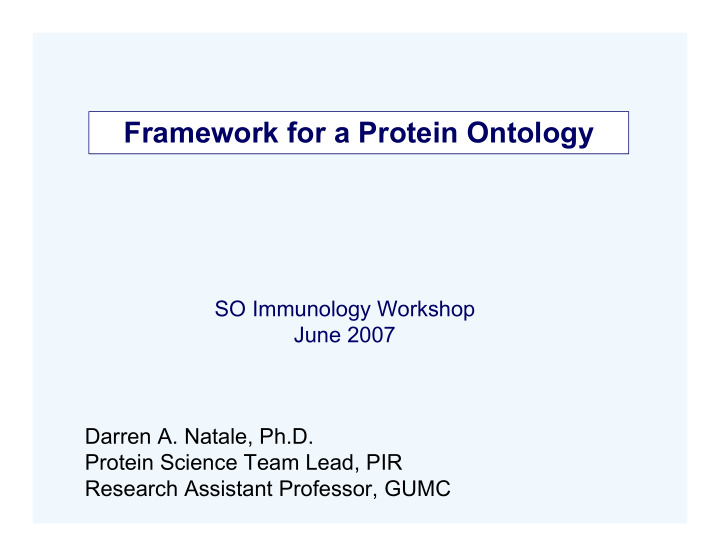



Framework for a Protein Ontology SO Immunology Workshop June 2007 Darren A. Natale, Ph.D. Protein Science Team Lead, PIR Research Assistant Professor, GUMC
GO: ontologies that pertain, in part, to the locations, the processes, and the functions of proteins PSI-MOD: ontology that describe the possible modifications to protein amino acid residues SO: ontology that can describe the possible causes of protein sequence, expression, or structure changes DO: ontology that can describe the possible effects of protein sequence, expression, or structure changes
Mothers against decapentaplegic homolog 2 Smad 2 GO annotation of SMAD2_HUMAN: Cellular Component: - nucleus Molecular Function: - protein binding Biological Process: - signal transduction - regulation of transcription, DNA-dependent
TGF- β TGF-beta receptor II I Smad 2 1 phosphorylation Smad 2 P P Smad 4 P ERK1 CAMK2 2 complex formation Smad 2 P P P P Smad 2 P P P P Smad 4 P Cytoplasm 3 nuclear translocation Smad 2 P P P Nucleus Smad 4 P 4 DNA binding ++ Transcription Regulation
“normal” •Cytoplasmic SMAD2_HUMAN PRO:00000011 Smad 2 TGF- β receptor •Forms complex SMAD2_HUMAN phosphorylated Smad 2 P P •Nuclear PRO:00000013 •Txn upregulation ERK1 phosphorylated •Forms complex SMAD2_HUMAN PRO:00000014 •Nuclear P Smad 2 P P •Txn upregulation++ CAMK2 •Forms complex SMAD2_HUMAN phosphorylated PRO:00000015 P Smad 2 P P •Cytoplasmic •No Txn upregulation alternatively spliced •Cytoplasmic SMAD2_HUMAN short form Smad 2 PRO:00000016 phosphorylated short •Nuclear SMAD2_HUMAN form Smad 2 P P •Txn upregulation PRO:00000018 point mutation •Doesn’t form complex Smad 2 x SMAD2_HUMAN (causative agent: •Cytoplasmic PRO:00000019 large intestine •No Txn upregulation carcinoma)
Important Considerations • Need to consider the various forms a protein might take • Need to consider the various forms a protein might take • Need to provide connections to established ontologies • Need to provide connections to established ontologies • Need to account for the possibility that a protein might not • Need to account for the possibility that a protein might not share the traits of its parent or siblings share the traits of its parent or siblings
%PRO:00000010 Smad2 <PRO:00000011 Smad2 sequence 1 (long form) >PRO:00000012 Smad2 sequence 1 phosphorylated form %PRO:00000013 Smad2 sequence 1, TGF- β receptor I-phosphorylated %PRO:00000014 Smad2 sequence 1, TGF- β receptor I and ERK1-phosphorylated has_modification MOD: O-phosphorylated L-serine %PRO:00000015 Smad2 sequence 1, TGF- β receptor I and CAMK2-phosphorylated has_modification MOD: O-phosphorylated L-threonine <PRO:00000016 Smad2 sequence 2 (short form) - splice variant has_function GO: TGF- β receptor, pathway-specific cytoplasmic mediator activity >PRO:00000017 Smad2 sequence 2 phosphorylated form has_function GO: SMAD binding %PRO:00000018 Smad2 sequence 2, TGF- β receptor I-phosphorylated has_function GO: transcription coactivator activity <PRO:00000019 Smad2 sequence 3 - genetic variant related to colorectal carcinoma participates_in GO: signal transduction participates_in GO: SMAD protein heteromerization participates_in GO: regulation of transcription, DNA-dependent located_in GO: nucleus part_of GO: transcription factor complex %PRO:00000015 Smad2 sequence 1, TGF- β receptor I and CAMK2-phosphorylated <PRO:00000016 Smad2 sequence 2 (short form) - splice variant >PRO:00000017 Smad2 sequence 2 phosphorylated form %PRO:00000018 Smad2 sequence 2, TGF- β receptor I-phosphorylated <PRO:00000019 Smad2 sequence 3 - genetic variant related to colorectal carcinoma has_agen t SO: amino_acid_substitution lacks_modification MOD: phosphorylated residue lacks_function GO: transcription coactivator activity agent_of DO: carcinoma of the large intestine % is_a < variant_of > derives_from
Recommend
More recommend